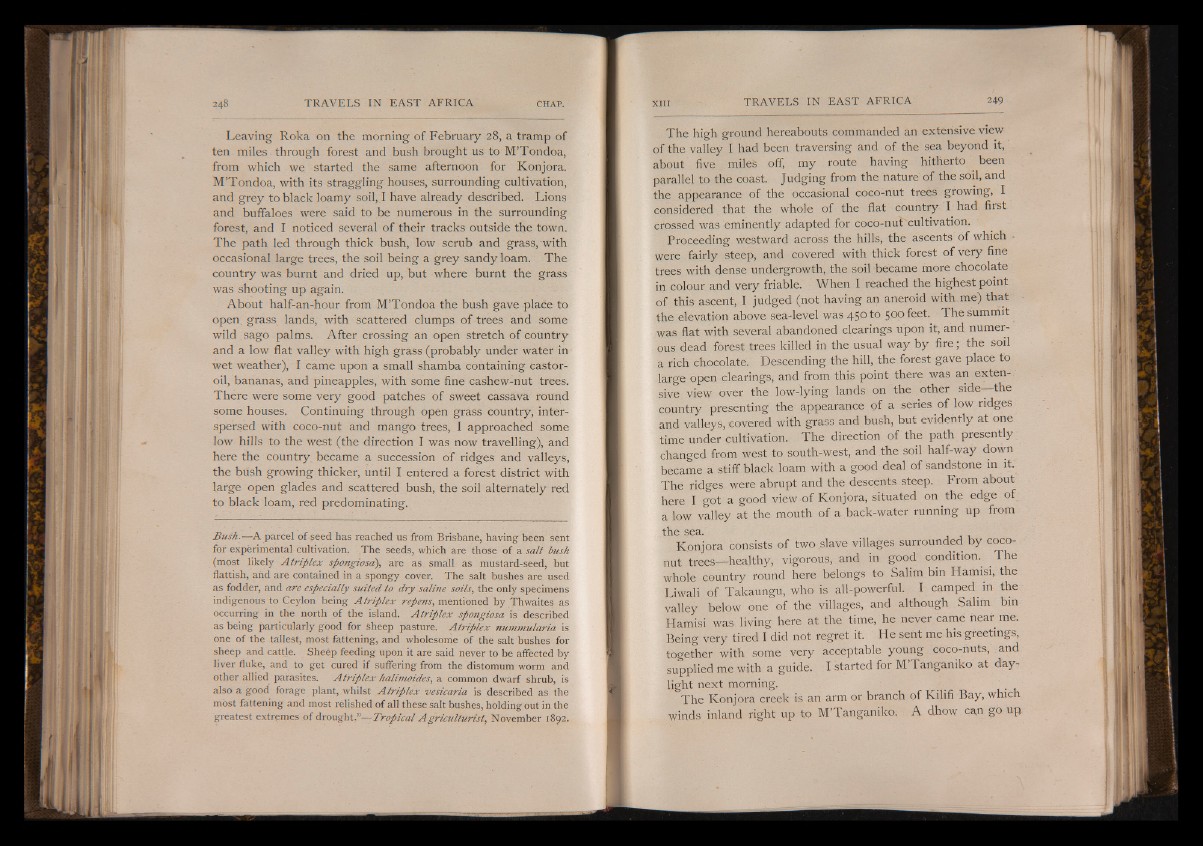
Leaving Roka on the morning of February 28, a tramp of
ten miles through forest and bush brought us to M’Tondoa,
from which we started the same afternoon for Konjora.
M’Tondoa, with its straggling houses, surrounding cultivation,
and grey to black loamy soil, I have already described. Lions
and buffaloes were said to be numerous in the surrounding
forest, and I noticed several of their tracks outside the town.
The path led through thick bush, low scrub and grass, with
occasional large trees, the soil being a grey sandy loam. The
country was burnt and dried up, but where burnt the grass
was shooting up again.
About half-an-hour from M’Tondoa the bush gave place to
open grass lands, with scattered clumps of trees and some
wild sago palms. After crossing an open stretch of country
and a low flat valley with high grass (probably under water in
wet weather), I came upon a small shamba containing castor-
oil, bananas, and pineapples, with some fine cashew-nut trees.
There were some very good patches of sweet cassava round
some houses. Continuing through open grass country, inter-
spersed with coco-nut and mango trees, I approached some
low hills to the west (the direction I was now travelling), and
here the country became a succession of ridges and valleys,
the bush growing thicker, until I entered a forest district with
large open glades and scattered bush, the soil alternately red
to black loam, red predominating.
R»ii4B -A parcel of seed has reached us from Brisbane, having been sent
for experimental cultivation. The seeds, which are those of a salt bush
(most likely A trip lex spongiosa), are as small as mustard-seed, but
flattish, and are contained in a spongy cover. The salt bushes are used
as fodder, and are especially suited to dry saline soils, the only specimens
indigenous to Ceylon being A trip lex repens, mentioned by Thwaites as
occurring in the north of the island. A trip lex spongiosa is described
as being particularly good for Sheep pasture. A triplex nummularia is
one of the tallest, most fattening, and wholesome of the salt bushes for
sheep and cattle. Sheep feeding upon it are said never to be affected by
liver fluke, and to get cured if suffering from the distomum worm and
other allied parasites. A trip lex halimoides, a common dwarf shrub, is
also a good forage plant, whilst A trip lex vesicaria is described as the
most fattening and most relished of all these salt bushes, holding out in the
greatest extremes of drought,”— Tropical Agriculturist, November 1892.
The high ground hereabouts commanded an extensive view
of the valley I had been traversing and of the sea beyond it,
about five miles off, my route having hitherto ^ been
parallel to the coast. Judging from the nature of the soil, and
the appearance of the occasional coco-nut trees growing, I
considered that the whole of the flat country I had first
crossed was eminently adapted for coco-nut'cultivation.
Proceeding westward across the hills, the ascents of which ■
were fairly steep, and covered with thick forest of very fine
trees with dense undergrowth, the soil became more chocolate
in colour and very friable. When I reached the highest point
of this ascent, I judged (not having an aneroid with me) tha.t
the elevation above sea-level was 450 to 500 feet. The summit
was flat with several abandoned clearings upon it, and numerous
dead forest trees killed in the usual way by fire; the soil
a rich chocolate. Descending the hill, the forest gave place to
large open clearings, and from this point there was an extensive
view over the low-lying lands on the other side the
country presenting the appearance of a series of low ridges
and valleys, covered with grass and bush, but evidently at one
time under cultivation. The direction of the path presently
changed from west to south-west, and the soil half-way down
became a stiff black loam with a good deal of sandstone in it.
The ridges were abrupt and the descents steep. From about
here I got a good view of Konjora, situated on the edge of
a low valley at the mouth of a back-water running up from
the sea.
Konjora consists of two slave villages surrounded by coconut
trees— healthy, vigorous, and in good condition. The
whole country round here belongs to Salim bin Hamisi, the
Liwali of Takaungu, who is all-powerful. I camped in the
valley below one of the villages, and although Salim bin
Hamisi was living here at the time, he never came near me.
Being very tired I did not regret it. He sent me his greetings,
together with some very acceptable young coco-nuts, and
supplied me with a guide. I started for M’Tanganiko at daylight
next morning.
The Konjora creek is an arm or branch of Kilifi Bay, which
winds inland right up to M’Tanganiko. A dhow can go up